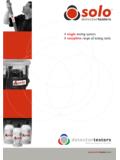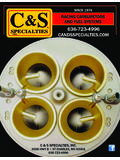Transcription of AEROSOL SMOKE DETECTOR TESTERS
1 THE DEFINITIVE JOURNAL FOR FIRE PROFESSIONALSSEPTEMBER SMOKEDETECTOR TESTERSA rticle reprintedfrom the September2004 issue of FireSafety Engineeringby Stewart Pepper, Technical DirectorNo Climb Products Ltd, Edison House, 163 Dixons Hill Road, Welham Green, Hertfordshire, AL9 7JE, : +44 (0)1707 282760 Fax: +44 (0) 1707 282777 E-mail: Web: SAFETY ENGINEERING GaseouspropellantexertingpressureProduct concentrateand liquefiedpropellantLiquefiedpropellantbe coming gasmixed withproduct01-04_FSE_0904_No Climb 16/9/04 16:18 Page 1 FIRE SAFETY ENGINEERINGSEPTEMBER concept of AEROSOL smokedetector TESTERS was invented andfirst filed as a patent application inSwitzerland in 1969 by Cerberus and standards around the worldrequire functional tests to confirm thatsmoke can enter the detection chamber ofpoint type SMOKE detectors .
2 This can bedone by generating simulated SMOKE or bythe use of suitable aerosols. AEROSOL smokedetector TESTERS are widely accepted as thepopular method of performing such testsbecause they are quick, simple andcontrollable. The substance used for thetest must not cause damage to, nor affectthe subsequent performance of, thedetector. Environmental and health andsafety issues must also not be principles of AEROSOL detectorsThe scientific term AEROSOL refers to smallparticles suspended in a gas but, inAEROSOLSMOKE DETECTORTESTERSS tewart Pepper, Technical Directorof No Climb Products, explains thebasic principles and discusses thefunctional and safety issues whichneed to be usage, it refers more often to thepressurised containers that we know anduse in so many of our activities.
3 Aerosolcanisters contain two essential components:the propellant and the active ingredient. Thepropellant s two main jobs are:a) to create pressure within the canister topush out the active ingredient, andb) to help break up the liquid droplets andmake a fine spray. The active ingredient (often a blend) isdependent on the application, and is the wanted product from the can ( thesynthetic SMOKE particles). Put together in acanister, which is designed to contain thepressure of the propellant, they are regulatedand dispensed by a valve and actuatorcombination.
4 The valve and actuatordetermine the rate and type of spray patternas well as providing a heavy influence on theparticle characteristics (themselves also afunction of the chemical ingredients). AEROSOL SMOKE DETECTOR TESTERS producea fine mist of particles, providing sizes andcharacteristics comparable to various typesof SMOKE . Ideally, they also provide a mix ofparticles optimised to activate quickly bothoptical and ionisation SMOKE of the correct chemicals for usewithin these products is of paramountimportance since there is a need to balancethe often conflicting requirements ofenvironmental and health and safetyregulations, (non)
5 Flammability, low costand, most importantly, compatibility withthe components from which detectors Issues and Design CriteriaParticulateThe particle size, particle distribution andparticle lifetime of the purposely-generated AEROSOL particles play a crucialrole in the responses and clearing times of the detectors on which they areused. Ionisation detectors are moresensitive to SMOKE particles and 1 micron and photoelectric(optical) between 1 and 10 microns. Auniversal test product therefore needs tobe producing particles to cover a rangeof particle sizes ( 10 m).
6 Othercharacteristics of the AEROSOL particlesare also crucial for activation of thedetector. By simulating these characteristics theaerosol canister simulates not just SMOKE but probably a wider spectrum ofsmokes than is produced by tests usingcertain real smokes (the characteristicsof which will depend on what substanceis being burned under what conditions).As such, AEROSOL testing can be arguedto be a more rounded test than using real SMOKE . It is certainly one that meetsthe core requirement of a test to:"confirm(s) that SMOKE can enter thedetector chamber and produce a firealarm signal ( by use of apparatus thatGaseouspropellantexertingpressurePro ductconcentrate andliquefiedpropellantLiquefiedpropellan tbecoming gasmixed with productFigure 1.)
7 Particle sizes01-04_FSE_0904_No Climb 16/9/04 16:18 Page 2 SEPTEMBER 2004 FIRE SAFETY simulated SMOKE or suitableaerosols around the DETECTOR )" BS 5839-1:2002 (d). Clearing timeA thorough test of the system will seek toensure that the horns / bells / sirens will beactivated by each DETECTOR individually,Both BS 5839 and NFPA 72, for example,require the checking of both SMOKE entry tothe sensing chamber andan alarmresponse. This means the panel beingautomatically or manually re-set after eachtest (which cannot be done until thedetector is clear of SMOKE ).
8 Clearing time istherefore almost as important as activationtime (not to mention probably being moreheavily influenced by the test media). Ideally SMOKE detectors will respond inthe fastest time (as allowed by circuitrydesign) and the test AEROSOL will clear(dissipate) in the shortest time to allow thedetector to be reset. A product whoseparticulate dissipates very quickly eitherneeds more spray (to remain long enoughfor time delayed detectors ) or must becontained within an AEROSOL lasting sprays (where less spray isrequired) have the disadvantage that theytake longer to clear (so delaying re-set)
9 And, often, a greater propensity for residueand of a dispenser enables an aerosolwith quick clearing time to be used ondetectors that require longer and ContaminationOver the years there have been concernsabout using AEROSOL canisters, because ofthe residues that can be left through their(mis)use. These residues have the potentialfor attracting dirt, dust and othercontaminants and therefore ultimatelyaffecting the DETECTOR can be left by many things inaddition to aerosols ( real SMOKE being oneof the worst offenders) and this is a keyissue particularly when it is so from AEROSOL SMOKE detectortesters are created, in liquid form, by thebreak-up of the chemical constituents asthey pass through the AEROSOL valve andactuator.
10 As volatile liquid particles travelthrough the air larger particles diminish insize, so that an AEROSOL spray canisterdesigned to project a long distance orremain for a period without dissipating,may need to start by producing largerparticles. Larger particles are alsosomewhat desirable in hand heldapplications on account of their ability totravel further in the air due to theiradditional momentum. Unfortunately, thelarger the size of the particle and the highertheir momentum, the more likely it is thatparticles will impact a surface and thenform a residue.













